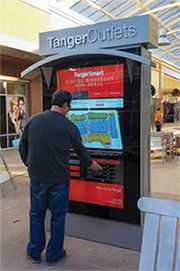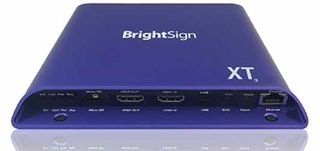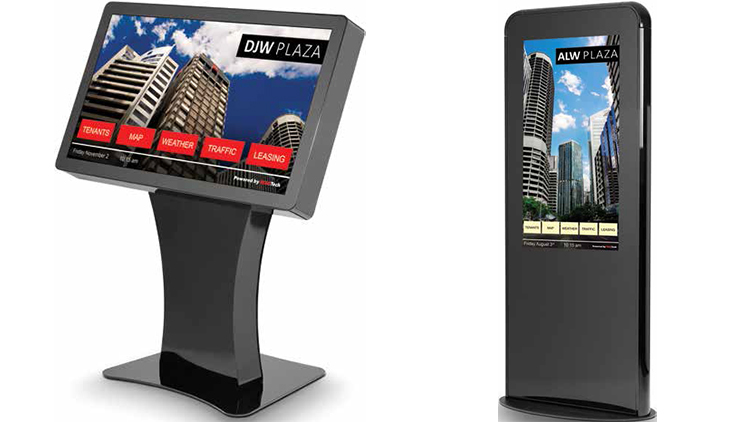It’s hard to remember a time when driving involved the routine use of printed maps and the occasional stop at the nearest gas station to ask for directions. These days, even if your vehicle isn’t equipped with a built-in GPS, you probably have at least one favorite smartphone app that can take you where you’re headed, as well as point out interesting landmarks or inconvenient obstacles along the way.
Developers of digital signage technology have thought a lot about this, and many of the wayfinding solutions out there apply how we’ve been conditioned to use GPS on the road to moving us through corporate and educational campuses, retail and convention centers, and healthcare facilities. The recurring theme? Wayfinding design take into account who its users will be and make their navigation experience as thought-free as possible.
THINK ABOUT DEMOGRAPHICS
“You have to think about your primary audience,” said Tor Stenbakken, senior manager of sign development at Four Winds Interactive (FWI), a digital signage platform developer headquartered in Denver, Colo. In other words, what demographic are you serving? “Would they be comfortable taking directions using a printed receipt, or using a mobile device? You’ve got generational differences [to consider.]” The positioning of the wayfinding kiosk is also important; if it isn’t in the visitor’s or employee’s line of sight, it isn’t much good. “The first consideration is really to make sure that you’re focusing on the end user and solving the problem of getting them from A to B.”
THINK ABOUT THE FUTURE

Outdoor wayfinding directory by Four Winds Interactive for Tanger Outlet Mall National Harbor in Maryland
NEC Display Solutions, headquartered in Chicago, Ill., recently introduced several new kiosk solutions in both portrait and landscape formats. The kiosks come with 42 and 46-inch displays with touch overlays, and are equipped with an Intel-powered PC. Richard Ventura, vice president of business development and solutions at NEC Display, says that one thing tech managers should think about is how their wayfinding requirements will evolve over time. “If you put [something] into your environment by piece-matching and going with the cheapest solution, there are no guarantees that kiosk is going to last, and that kiosk is going to meet all your needs,” he said. Touch capabilities are one example: not all kiosks can be upgraded to support touch technology––in many cases, if a facility wants to incorporate interaction in its displays, it needs to purchase new ones outright rather than adding the feature to what they’ve already got. “[When] you’re designing a solution, you need to plan for the future. Today you may think you only need X, Y, and Z, but down the road you might need to add about nine other things to it.”
THINK ABOUT TOUCH (SOME MORE) & ENGAGEMENT
For Jeff Hastings, CEO at BrightSign LLC, a digital signage player developer in Los Gatos, Calif., touch “is a key development in wayfinding, and support of HTML5 is essential to this functionality, as it enables the viewer to dig many layers deep to find the content they’re seeking,” he noted. He explains that BrightSign’s players are “driven by a hardware-accelerated HTML5 rendering engine that’s on par with very high-end PCs,” which is what’s needed for interactivity. He says that his company is also seeing more demand for wayfinding systems that incorporate live content from the web—such as social media feeds, flight tracking information, and weather reports—which is also made possible with HTML5. Beacon/BTLE technology, which senses when someone walks by a display with the goal of engaging them via their mobile device, also figures into BrightSign’s offerings.
ViewSonic Corp., a display solutions manufacturer based in Brea, Calif., notes the combination of its SW-014 Video Wall Deployment Solution, the SW-015 Artistic Video Wall Deployment Solution (both powered by Userful software), as well as the company’s commercial displays, results in the ability to deploy up to 40 4K displays with the use of one high-end PC. The manufacturer says that these solutions are not only suited for marketing and advertising, but also for interactive use in command and control facilities as well as for wayfinding.
THINK ABOUT MAPS

Thoughtful map design plays a central role in how successful a wayfinding system is, and Stenbakken notes that the relationship between the user’s position in front of the map and how things are positioned on it comes into play. (Those still familiar with printed maps probably have recollections of having to turn themselves around on the spot in order to read them properly, and set off in the right direction.) “You want to make sure that they don’t have to rearrange themselves in order to figure out where they’re going,” he said. He says that context is also important: by giving the user two different views of the facility—a high-level overview, and then a more detailed map—helps people orient themselves. And, just like a GPS in a car, people benefit from turn-by-turn directions—“being able to not only show them a line path, but actually give them textual directions that get them to where they’re going.”
Color coding is another effective method of facilitating the user’s experience; assigning similar departments—or, in retail centers, store—the same color draws their eye to their area of interest. Assigning off-limits sections of the facility darker colors, like gray or even black, also helps to keep them out of the “backstage” areas of your organization. While highlighting a building’s major landmarks, such as statues or fountains, is helpful, Stenbakken cautions against too much detail: “If it’s a major landmark, we always try to include those on maps, but we really try to limit it to what is absolutely essential,” he said.
FWI’s platform now incorporates panning and zooming, which again helps users better orient themselves. Stenbakken predicts that with technologies like Wi-Fi triangulation, wayfinding will soon be able to adopt another feature we’re accustomed to in vehicular GPS: the ability for systems to identify the user’s location within a facility. “That’s something I’m really excited about in the future, because that gives the user even more context as to where they are as they’re moving through a building,” he said. “[It’s] going back to that simplicity and not making them think too much, but accomplishing their end goal.”
Carolyn Heinze is a regular AV Technology contributor.
Info
BRIGHTSIGN LLC
www.brightsign.biz
FOUR WINDS INTERACTIVE (FWI)
www.fourwindsinteractive.com
NEC DISPLAY SOLUTIONS
www.necdisplay.com
VIEWSONIC
www.viewsonic.com










